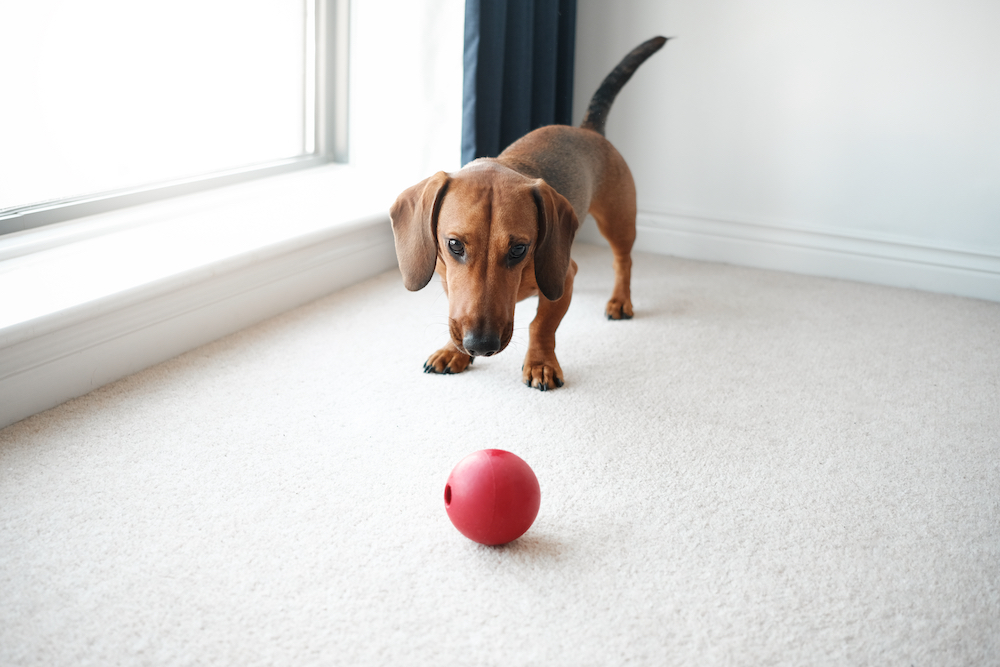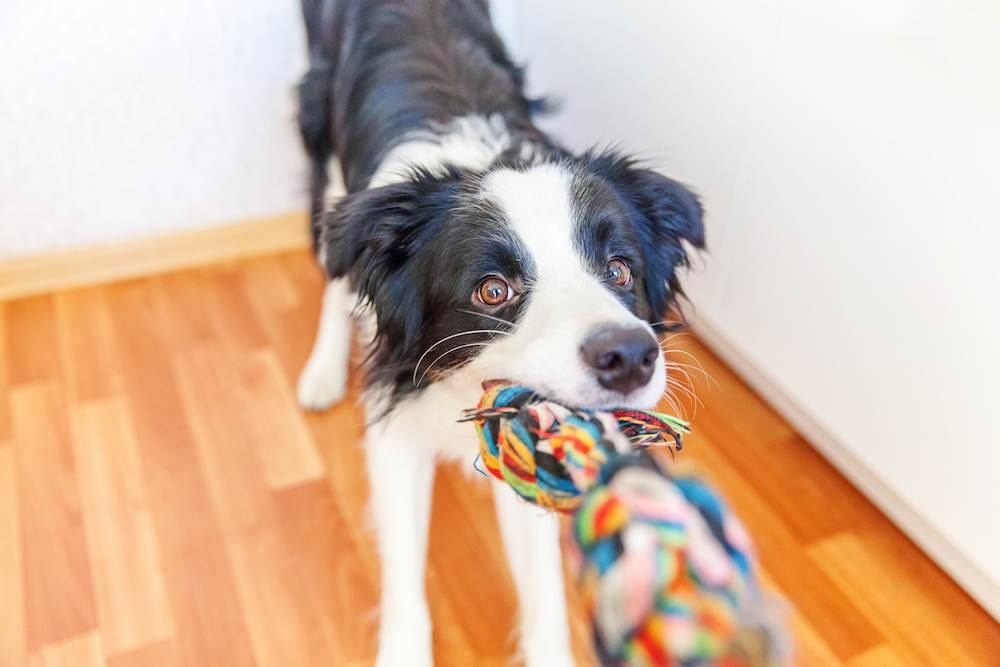Heavy rain, snow, ice—on extreme-weather days, you may be tempted to just hang out on the couch (hey, us too). But if you have a high-energy dog who’s used to lots of walks and outdoor activity, a completely chill day inside is not an option.
You probably already know that boredom can lead to undesirable behavior in a dog, such as chewing their paws, digging, or getting into mischief by nosing around in the trash or tearing up toilet paper.
Boredom is also an issue because it’s unpleasant, and, as loving guardians, we want our dogs to be happy and fulfilled.
Luckily, there are some simple, fun ways to keep your dog mentally and physically stimulated while staying warm and dry indoors. (Of course, you’ll still need to bundle up for those potty breaks.)
Along with preventing boredom, engaging in these activities with your dog can help boost your relationship. “When you’re training anything new, teaching your dog new things, you’re really opening up your dialogue with that animal, which is pretty incredible,” says certified professional dog trainer Robert Haussmann, co-founder and lead trainer at Dogboy NYC. “It’s a great way to build a strong bond with your dog through mutual understanding.”
And it’s important to keep in mind just how valuable mental exercise can be for a dog—dogs need both physical and mental activity for their wellbeing, and mind workouts can go a long way toward draining a dog’s energy and keeping them satisfied on days when they can’t go outside.
Here are some of our favorite ways to enjoy an indoor day with your dog.

Food-dispensing toys
Many dogs are natural foragers; that is, they like working for their food, searching, digging, and generally having to track it down. Food-dispensing toys give dogs that satisfying experience, and can be useful with dogs who tend to eat too fast. There are several different types, including:
- Puzzle feeder: With a puzzle feeder—a contraption with pockets and holes covered by obstacles—your dog has to nudge, spin, pull or otherwise manipulate different sections to reveal bits of food.
- Hollow toys: Fill one of these rubber toys—a Kong, for example—with food and freeze it. Your dog will have to take their time working all of the food out.
- Snuffle mat: This is a flat sheet of fabric with other pieces of fabric sewn to it, mimicking tall grass. You hide treats in it, and your dog sniffs and digs through it to retrieve them. Don’t have a snuffle mat on hand? You can make your own.
Hallway fetch
If your pup loves to chase and retrieve, you can make fetch happen inside. Toss the ball down a hallway and call your dog to grab it, bring it back to you and drop it. If you live in an apartment building, and you’re confident the neighbors don’t mind, use the hallway outside your door—just be mindful to avoid excessive noise.

Tug
Tug is exactly what it sounds like—a game in which you and your dog pull a toy back and forth, trying to take it from each other. It doesn’t require a lot of space, and it has the added benefit of providing you and your dog with a burst of good exercise in a short amount of time. Use an item with some length, such as a rope toy, so there’s room for you to grab with a hand or two and your dog to grab with their mouth.
It’s best to play tug on your terms. Add rules to play this game: have your dog sit or “go to place” before beginning the game, and—when you say so—make sure they release the tug (another fun indoor activity: teaching your dog the “drop it” skill!). The reward is that the dog gets to re-engage and start the game again. Let your dog win some of the time to build confidence.
Hide and seek
It takes a bit of training to teach a dog how to play this game, but it’s worth it. “You’re teaching the dog something fun, and making it fun for yourself, too,” Haussmann says. To start, when you hide, have someone else hold your dog on a leash and let the dog see where you’re hiding. Use the word “find” and have the other person release the dog. When they get to you, reward them with praise and a treat. Make the hiding place progressively more challenging, eventually not allowing the dog to see where you’re hiding.
Or play by taking turns calling the dog, Haussmann suggests. “Have multiple household members calling the dog from one spot to another, finding new spots every time,” he says. “So the dog has to find them in a different room, or behind the door, or under the bed—all those things are super fun.”

Scent work
Related to hide and seek, scent work, or nose work, involves hiding treats or toys for your dog to find. “It’s a natural behavior, and it’s led by the dog. It’s very interesting to them,” Haussmann says. “A lot of times, they’re not really permitted to explore the way they’d like. We stop them from sniffing gross stuff, we stop them from sniffing crotches or dog butts. But they have this amazing tool at the end of their face to track and find things, and really allowing them to use it can be incredibly enriching to them. You can do that by teaching ‘find it,’ where the dog has to find a treat or food item, and then making it increasingly more difficult.”
Haussmann notes that you can use items around your home to play this game. For example: put the food or toys in pieces of food storage containers with lids, or empty cardboard egg cartons that you shut and let the dog tear apart.
Training
Use your indoor time as an opportunity to practice skills or tricks you’ve taught your dog, or to teach them a new one. This is especially important with high-energy dogs who might have a tougher time being stuck inside. “You might have a dog that’s really hyper, high energy and easily distracted—but through training, you can actually help that dog learn how to focus better,” Haussmann says. “Training is about giving an animal context about the world that it lives in, building trust, and having fun. Your dog sees you as a partner in that.”
The post 6 Ways to Keep Your Dog Happy on Indoor Days appeared first on The Farmer's Dog.
Comments
Post a Comment